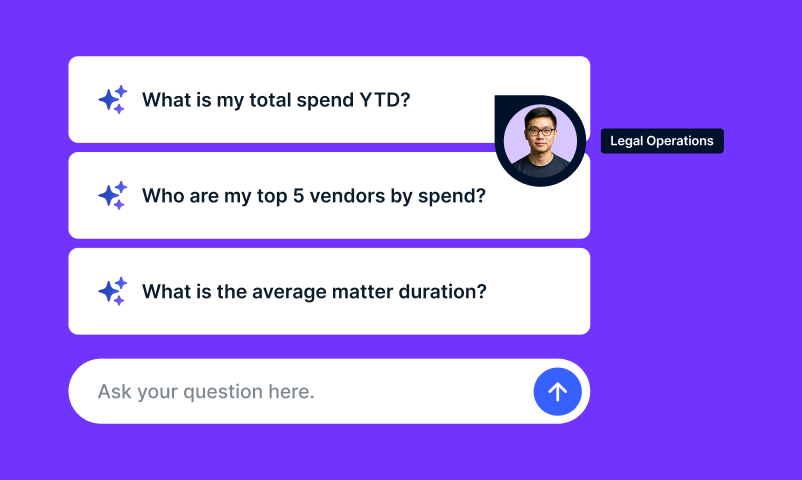This article was first published on LegalDive.
The history of enterprise legal management (ELM) is a study of slow-moving but immensely consequential shifts in purpose, mission and access. For several years, ELM was limited to matter management and spend management. After that, the first paradigm shift occurred when the best ELM platforms began to facilitate engagement, focus on process, offer a user-friendly environment, empower organizations and enable management of many other legal methods.
The second paradigm shift is happening now, taking advantage of the advances in artificial intelligence (AI) and machine learning technology. Today, the top ELM tools combine the powers of artificial intelligence with existing ELM rules to offer a game-changing solution for legal teams. This combination enables legal to operate faster, more accurately, and more efficiently — in everything from invoice processing and contract management to vendor management and many other tasks.
Just as critical to legal departments are the data insights that this new combination provides. ELM’s embrace of AI empowers organizations to look between the rules to find missed savings, provide real-time invoice error detection and analyze how vendors and bill reviewers perform.
So, with all the insights and efficiency this combination of AI and ELM can provide, why are some still hesitant to embrace the change? The embrace of this paradigm shift is not universal – and their arguments deserve examination.
Let’s look at the three most common arguments against AI:
It’s not worth the hype.
The most common blowback against this is simple: AI-enabled technology isn’t worth the hype.
“We have yet to see AI tools in this industry that fully replace people or processes,” one e-discovery specialist says in a LegalTech News piece. “They are better marketed as augmenting a procedure, improving the performance of a team or workstream, or adding automation and precision to workflows.”
True, AI is not sufficiently advanced to replace lawyers or remove critical thinking from processes, but this does not mean there isn’t a huge amount of value in what AI can do now. Where AI excels is in augmenting the work of legal professionals (typically the stuff they don’t want to do), providing insight from large, unstructured, unseen data and automation of simple, highly repetitive tasks. So, while AI is not a “magic bullet,” it offers genuine benefits, not just the reduction of “time spent in the process” but improvements to consistency, transparency, and mitigation of risk, all of which directly impact the top and bottom lines of your business.
To unlock these benefits, look for vendors that have a clear roadmap and will work with your organization to develop a successful rollout plan and deploy their AI+ELM solution to augment and enhance your capabilities.
It doesn’t solve our specific problems.
Transparency in the selection process will go a long way toward choosing a product that does solve those specific issues. Legal technology vendors should clearly lay out the purpose of their AI solution. What problems will it solve? What is the implementation process? What kind of support and training will they provide? What does the return on investment (ROI) look like? On the user side, legal departments must do their homework with stakeholders before they rush into buying a tech solution. Legal should have a clear picture of success and should come prepared with use cases to illustrate the desired outcome.
“Technology for technology’s sake” isn’t a solution. As much as AI can be used, there remains a bigger challenge of whether it will be used. Understanding the use case, implementation, and return on investment are especially important; bringing in nascent technology means you must have a strong change management process. Understanding how the organization will adopt the technology and including all key individuals — from the influencers to the naysayers — are critical to the successful rollout of AI.
With that type of transparency and communication, organizations can find the right vendor for their project needs. Remember this quote from business leader Andrew Shimek when embarking on the search:
“You shouldn’t chase AI in a vacuum,” one industry expert said in an Iltacon panel. “You should think about what are the problems that we have that need to be solved. And if AI is a critical tool that can help solve that faster and better, not at the expense of quality, let’s adopt it. But I think it’s use-case first and AI second—not AI in a vacuum.”
It doesn’t provide the data for success.
Nowadays, many AI solutions are trained out of the box, eliminating the need to collect enormous amounts of data to get started. Of course, to create a highly custom solution, you will need to spend time collecting data, training, and validating. This can be difficult and risky.
Like any digital transformation, you should ask yourself whether you are innovating to sustain the existing approach (by making it faster, more efficient, cheaper, etc.) or disrupting the existing one. Most innovation is centered around sustaining innovation — of which success comes through iteration, not giant leaps. “Don’t let best get in the way of better” is a great motto to remember.
Starting with out-of-the-box solutions that might not be an exact fit BUT offer a faster pathway to value and building internal support for such a transformation is a secure way of creating success, helping you learn, measure and prepare for more customized solutions in the future.
Embracing the paradigm shift
McKinsey’s State of AI survey in 2021 shows that AI adoption continues to grow with significant benefits; most respondents say that adopting AI has resulted in a demonstrable positive impact. In fact, a report from the Corporate Legal Operations Consortium (CLOC) that adoption of AI by legal teams doubled from 2020 to 2021 – from one in 10 teams to one in five.
Legal professionals everywhere are embracing the AI+ELM paradigm shift. On its most basic level, AI platforms can augment and improve both legal and business processes for corporate legal departments, law firms, contract professionals, and procurement teams. With the focused mission of helping business professionals get more work done faster, an AI engine can automate the existing repetitive, manual, and costly legal processes, enabling continuous learning and workflow improvements. The best intelligence platforms combine advanced AI techniques with workflow management to empower organizations with AI that not only finds and reports on things but does things for you.
The bottom line? While AI is not coming for lawyers’ jobs — and won’t be any time soon — the most innovative, forward-thinking legal departments recognize this paradigm shift and are acting to bolster their arsenal with AI-enabled workflow management solutions.
Learn how Onit’s ELM solutions can help your enterprise embrace this paradigm shift.




